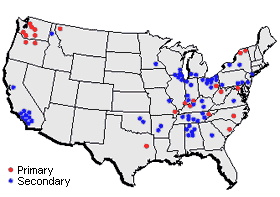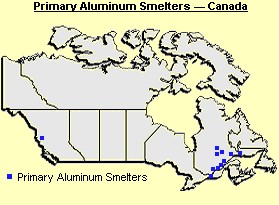Trends: Distribution of Production Plants

Environmental Issues
International Competition
Major Products and Markets
Regulations and NOx Control
Summary
Trends / Major Products
Trends / Employment and Productivity
Trends / Energy Consumption by Fuel
Trends / Primary Aluminum Production
Trends / Total Supply of Aluminum
Trends / World Aluminum Output
Trends / Distribution of Power Plants
Trends / Distribution of Processing Plantshref=”http://www.heattreatconsortium.com/MetalsAdvisor/aluminum/industry_overview/trends/trends_distribution_processing_plants.htm”>Trends / Distribution of Processing Plants
Primary aluminum smelting is an electricity intensive process. As a result, primary smelters are located in regions with low-cost hydroelectric electric power (i.e., BPA*, TVA*, and Upstate New York). Secondary smelting plants can use either electricity or, more commonly, natural gas for remelting of aluminum scrap. These plants are typically located near large end-use markets and/or sources of scrap.
*BPA = Bonneville Power Administration
*TVA = Tennessee Valley Administration
Canadian Primary Production
There are four primary aluminum producers in Canada operating eleven mills. Alcan, the largest producer, operates seven mills. The other four companies each operate a single mill. All but one of the mills is located in Quebec; the only smelter outside Quebec is in British Columbia. Canadian production capacity is about 2.3 million metric tons per year – a little over half the U.S. Primary production capacity.

Aluminum Statistical Review for 1993, Aluminum Association, p. 27
